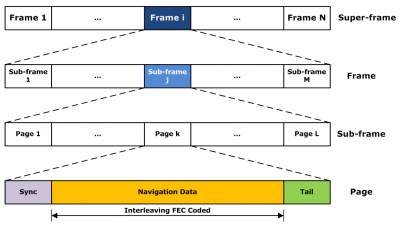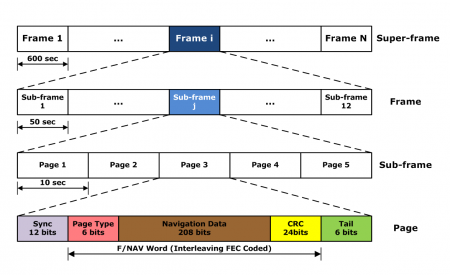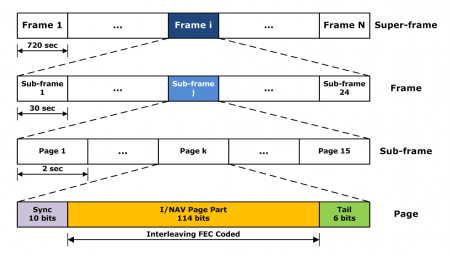If you wish to contribute or participate in the discussions about articles you are invited to contact the Editor
Galileo Navigation Message: Difference between revisions
mNo edit summary |
No edit summary |
||
| Line 6: | Line 6: | ||
|Title={{PAGENAME}} | |Title={{PAGENAME}} | ||
}} | }} | ||
The Galileo satellites will broadcast five types of data in four navigation messages: The Freely accessible Navigation Message (F/NAV) and Integrity Navigation Message (I/NAV), the Commercial Navigation Message (C/NAV) and the Governmental Navigation Message (G/NAV). Next table | The Galileo satellites will broadcast five types of data in four navigation messages: The Freely accessible Navigation Message (F/NAV) and Integrity Navigation Message (I/NAV), the Commercial Navigation Message (C/NAV) and the Governmental Navigation Message (G/NAV). Next table 1 summarises the content of the Galileo messages, with an indication of the associated channels and services (table inspired in [Hofmann-Wellenhof et al., 2008]). | ||
[[File:Galileo Messages.png|none|thumb|400px|alt=galileo navigation messages|'''''Table | [[File:Galileo Messages.png|none|thumb|400px|alt=galileo navigation messages|'''''Table 1:''''' Content of the Galileo message types]] | ||
As represented in the table above Galileo will offer several types of services with different purposes and to suit the needs of different types of users: | As represented in the table above Galileo will offer several types of services with different purposes and to suit the needs of different types of users: | ||
| Line 20: | Line 20: | ||
The G/NAV navigation message does not belong to the public domain and the C/NAV is not yet defined. | The G/NAV navigation message does not belong to the public domain and the C/NAV is not yet defined. | ||
== General Structure and Contents == | |||
[[ | According with the current published [Galileo SIS ICD, 2010] <ref name="GAL_SIS_ICD_2010">[Galileo SIS ICD, 2010] Galileo Open Service Signal In Space Interface Control Document (OS SIS ICD) Issue 1, Revision 1, 1 September 2010, 2010</ref> both F/NAV and I/NAV navigation messages are called super-frame and broadcast as a sequence of frames that are composed of several sub-frames which in turn is composed by several pages. | ||
[[File:Galileo Navigation Message Structure.png|none|thumb|400px|alt=Galileo Navigation Message General Structure|'''''Figure 2:''''' Galileo Navigation Message Structure]] | [[File:Galileo Navigation Message Structure.png|none|thumb|400px|alt=Galileo Navigation Message General Structure|'''''Figure 1:''''' Galileo Navigation Message Structure]] | ||
The general structure of the navigation messages are common but the number of sub-frames and pages as well as the duration of each page are not the same, as represented in the following table. | |||
[[File:Frame Structure.png|none|thumb|400px|alt=frame structure|'''''Table 2:''''' Galileo Navigation Message Frame Structure]] | |||
This arrangement allows accomplishing the three different main categories of data to be transmitted at different rates: | This arrangement allows accomplishing the three different main categories of data to be transmitted at different rates: | ||
| Line 32: | Line 36: | ||
The page starts with a Synchronisation Word (SW) followed by the interleaving FEC (Forward Error Correction) coded navigation data and ends with tail bits for the FEC decoding. In addition both navigation messages transmit a CRC data field in order to detect corrupted data. The size of this field is different in each navigation message. | The page starts with a Synchronisation Word (SW) followed by the interleaving FEC (Forward Error Correction) coded navigation data and ends with tail bits for the FEC decoding. In addition both navigation messages transmit a CRC data field in order to detect corrupted data. The size of this field is different in each navigation message. | ||
Three levels of error coding are applied to the Galileo Message Data Stream: | Three levels of error coding are applied to the Galileo Message Data Stream: | ||
# A Cyclic Redundancy Check (CRC) with error detection capabilities after recovery of the received data | # A Cyclic Redundancy Check (CRC) with error detection capabilities after recovery of the received data; | ||
# A one-half rate Forward Error Correction (FEC). Tail Bits (sequence of zeros) to allow Viterbi decoding | # A one-half rate Forward Error Correction (FEC). Tail Bits (sequence of zeros) to allow Viterbi decoding; | ||
# Block Interleaving on the resulting frames: provides robustness to the FEC decoding algorithm by avoiding packets of errors. This scheme allows reducing the bit error ratio in the increased data rates. | # Block Interleaving on the resulting frames: provides robustness to the FEC decoding algorithm by avoiding packets of errors. This scheme allows reducing the bit error ratio in the increased data rates. | ||
As referred, the FEC coded symbols are transmitted interleaved within the page and because of that the navigation data can only be read when the complete interleaving FEC coded part is received. | As referred, the FEC coded symbols are transmitted interleaved within the page and because of that the navigation data can only be read when the complete interleaving FEC coded part is received. | ||
The following table summarizes the parameters transmitted by FNAV and INAV messages. | |||
[[File:Params.png|none|thumb|400px|alt=Params|'''''Table 3:''''' Galileo Navigation Message Parameters]] | |||
As can be seen in the above table the parameters transmitted in F/NAV and I/NAV has the same size except for signal and message specific parameters, such as "Issue of Data (IOD)" and "Navigation Data Validity and Signal Health Status". In the case of "Satellite Almanac" the size isn't also the same because that parameter includes the "Satellite signal health status". | |||
The Galileo ephemeris parameters are [[GPS and Galileo Satellite Coordinates Computation|Keplerian-like orbital elements as in GPS]]. The nominal period update is 3 hours, being valid for a 4 hours time interval. The 1-hour overlap interval is intended to help against short outages or delays. The Galileo Almanac is also similar to the GPS and GLONASS ones. | The Galileo ephemeris parameters are [[GPS and Galileo Satellite Coordinates Computation|Keplerian-like orbital elements as in GPS]]. The nominal period update is 3 hours, being valid for a 4 hours time interval. The 1-hour overlap interval is intended to help against short outages or delays. The Galileo Almanac is also similar to the GPS and GLONASS ones. | ||
== F/NAV Structure == | |||
As represented on table 2 the F/NAV navigation message is transmitted on channel E5a-I at a rate of 25 bps according with the following structure. | |||
[[File:Fnav.png|none|thumb|450px|alt=Fnav|'''''Figure 2:''''' F/NAV Navigation Message Structure]] | |||
Each frame of the F/NAV message has the duration of 600 seconds and is composed by 12 sub-frames. In turn, each sub-frame has the duration of 50 seconds and is composed by 5 pages with the duration of 10 seconds. The page itself comprises 3 main fields: | |||
* Synchronisation pattern: has a length of 12 bits and is always 101101110000 being its purpose to allow the receiver be able to achieve synchronisation to the page boundary; | |||
* F/NAV word: has a length of 238 bits and is the interleaving FEC encoded part of the page that encodes the fields Page Type, Navigation Data and CRC. | |||
* Tail: has a length of 6 bits and consists of 6 zero-values that are used to enable the completion of the FEC decoding of each page. | |||
The Page Type field identifies the sent page which allows the user-receivers to react accordingly and grants the possibility of change the pages sequencing keeping backward compatibility. The CRC is used as the most inner mechanism of errors detection because is computed only on the Page Type and Navigation Data fields which in fact is the most important data of the page. | |||
== I/NAV Structure == | |||
The I/NAV navigation message is transmitted on both E1B and E5b-I channels at a rate of 125 bps. The two versions of the I/NAV message are disseminated through the same structure being its content also the same but not aligned over the time. | |||
[[File:Inav.png|none|thumb|450px|alt=Inav|'''''Figure 3:''''' I/NAV Navigation Message Structure]] | |||
Each frame of the I/NAV message has a duration of 720 seconds and is composed by 24 sub-frames. In turn, each sub-frame has the duration of 30 seconds and is composed by 15 pages with the duration of 2 seconds. The page itself is composed by 3 fields: | |||
* Synchronisation pattern: has a length of 10 bits and is always 0101100000 being its purpose to allow the receiver be able to achieve synchronisation to the page boundary; | |||
* I/NAV page part: has a length of 114 bits and is the interleaving FEC encoded part of the page where the navigation data is conveyed. | |||
* Tail: has a length of 6 bits and consists of 6 zero-value bits that are used to enable the completion of the FEC decoding of each page part. | |||
The page part of the message can be even or odd page and are always broadcast one after the other. In channel E1B the even part is transmitted in first place while in channel E5b-I the odd part is transmitted in second place. The combination of two page parts constitutes a valid set of data (Nominal Page) that has to be parsed together to get the Navigation Data. | |||
==Notes== | ==Notes== | ||
Revision as of 11:31, 9 November 2012
| Fundamentals | |
|---|---|
| Title | Galileo Navigation Message |
| Author(s) | J. Sanz Subirana, JM. Juan Zornoza and M. Hernandez-Pajares, University of Catalunia, Spain. |
| Level | Basic |
| Year of Publication | 2011 |
The Galileo satellites will broadcast five types of data in four navigation messages: The Freely accessible Navigation Message (F/NAV) and Integrity Navigation Message (I/NAV), the Commercial Navigation Message (C/NAV) and the Governmental Navigation Message (G/NAV). Next table 1 summarises the content of the Galileo messages, with an indication of the associated channels and services (table inspired in [Hofmann-Wellenhof et al., 2008]).
As represented in the table above Galileo will offer several types of services with different purposes and to suit the needs of different types of users:
- The Integrity data will provide time-alarms and parameters to compute the integrity risk to support Safety-of-Life applications.
- The Supplementary data is expected to provide information to support different envisaged commercial services as differential corrections for High Precision Positioning Service, and different kind of information data as weather alerts, traffic information... The data is encrypted to control the access to authorised users by the service providers.
- The Public Regulated data is under governmental control and it is devoted to the Public Regulated Service (PRS). The system will guarantee a high continuity of service with controlled access by encryption of data.
- The Search and Rescue data will provide the capability to send acknowledgment SAR messages to a Beacon equipped with a suitable Galileo receiver.
The G/NAV navigation message does not belong to the public domain and the C/NAV is not yet defined.
General Structure and Contents
According with the current published [Galileo SIS ICD, 2010] [1] both F/NAV and I/NAV navigation messages are called super-frame and broadcast as a sequence of frames that are composed of several sub-frames which in turn is composed by several pages.
The general structure of the navigation messages are common but the number of sub-frames and pages as well as the duration of each page are not the same, as represented in the following table.
This arrangement allows accomplishing the three different main categories of data to be transmitted at different rates:
- Fast rate (for urgent data, such as integrity): page.
- Medium rate (Ephemeris, Clock Correction, ...): sub-frame.
- Slow rates (Almanacs): frame.
The page starts with a Synchronisation Word (SW) followed by the interleaving FEC (Forward Error Correction) coded navigation data and ends with tail bits for the FEC decoding. In addition both navigation messages transmit a CRC data field in order to detect corrupted data. The size of this field is different in each navigation message. Three levels of error coding are applied to the Galileo Message Data Stream:
- A Cyclic Redundancy Check (CRC) with error detection capabilities after recovery of the received data;
- A one-half rate Forward Error Correction (FEC). Tail Bits (sequence of zeros) to allow Viterbi decoding;
- Block Interleaving on the resulting frames: provides robustness to the FEC decoding algorithm by avoiding packets of errors. This scheme allows reducing the bit error ratio in the increased data rates.
As referred, the FEC coded symbols are transmitted interleaved within the page and because of that the navigation data can only be read when the complete interleaving FEC coded part is received.
The following table summarizes the parameters transmitted by FNAV and INAV messages.
As can be seen in the above table the parameters transmitted in F/NAV and I/NAV has the same size except for signal and message specific parameters, such as "Issue of Data (IOD)" and "Navigation Data Validity and Signal Health Status". In the case of "Satellite Almanac" the size isn't also the same because that parameter includes the "Satellite signal health status". The Galileo ephemeris parameters are Keplerian-like orbital elements as in GPS. The nominal period update is 3 hours, being valid for a 4 hours time interval. The 1-hour overlap interval is intended to help against short outages or delays. The Galileo Almanac is also similar to the GPS and GLONASS ones.
F/NAV Structure
As represented on table 2 the F/NAV navigation message is transmitted on channel E5a-I at a rate of 25 bps according with the following structure.
Each frame of the F/NAV message has the duration of 600 seconds and is composed by 12 sub-frames. In turn, each sub-frame has the duration of 50 seconds and is composed by 5 pages with the duration of 10 seconds. The page itself comprises 3 main fields:
- Synchronisation pattern: has a length of 12 bits and is always 101101110000 being its purpose to allow the receiver be able to achieve synchronisation to the page boundary;
- F/NAV word: has a length of 238 bits and is the interleaving FEC encoded part of the page that encodes the fields Page Type, Navigation Data and CRC.
- Tail: has a length of 6 bits and consists of 6 zero-values that are used to enable the completion of the FEC decoding of each page.
The Page Type field identifies the sent page which allows the user-receivers to react accordingly and grants the possibility of change the pages sequencing keeping backward compatibility. The CRC is used as the most inner mechanism of errors detection because is computed only on the Page Type and Navigation Data fields which in fact is the most important data of the page.
I/NAV Structure
The I/NAV navigation message is transmitted on both E1B and E5b-I channels at a rate of 125 bps. The two versions of the I/NAV message are disseminated through the same structure being its content also the same but not aligned over the time.
Each frame of the I/NAV message has a duration of 720 seconds and is composed by 24 sub-frames. In turn, each sub-frame has the duration of 30 seconds and is composed by 15 pages with the duration of 2 seconds. The page itself is composed by 3 fields:
- Synchronisation pattern: has a length of 10 bits and is always 0101100000 being its purpose to allow the receiver be able to achieve synchronisation to the page boundary;
- I/NAV page part: has a length of 114 bits and is the interleaving FEC encoded part of the page where the navigation data is conveyed.
- Tail: has a length of 6 bits and consists of 6 zero-value bits that are used to enable the completion of the FEC decoding of each page part.
The page part of the message can be even or odd page and are always broadcast one after the other. In channel E1B the even part is transmitted in first place while in channel E5b-I the odd part is transmitted in second place. The combination of two page parts constitutes a valid set of data (Nominal Page) that has to be parsed together to get the Navigation Data.
Notes
References
- ^ [Galileo SIS ICD, 2010] Galileo Open Service Signal In Space Interface Control Document (OS SIS ICD) Issue 1, Revision 1, 1 September 2010, 2010
- Hofmann-Wellenhof, B., Lichtenegger, H., K. and Wasle, E., 2008. GNSS - Global Navigation Satellite Systems. Springer-Verlag, Wien, Austria.
- Powe, M., 2006. Introduction to Galileo. powerpoint presentation, progeny.






